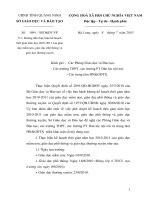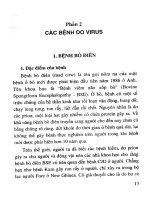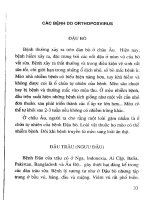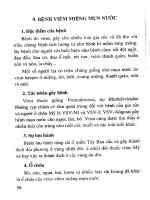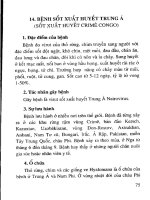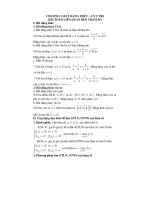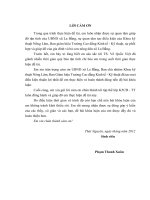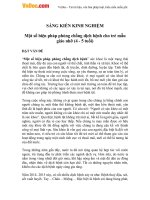Anh văn khối 12_Đề số 4_Tài liệu tự ôn tập tại nhà trong thời gian nghỉ học phòng chống dịch bệnh do virut corona gây ra
Bạn đang xem bản rút gọn của tài liệu. Xem và tải ngay bản đầy đủ của tài liệu tại đây (128.02 KB, 7 trang )
<span class='text_page_counter'>(1)</span><div class='page_container' data-page=1>
<b>ĐỀ SỐ 4</b>
<i>(Đề thi có 06 trang)</i>
<b>ĐỀ ÔN LUYỆN CUỐI HỌC KỲ 1</b>
Môn: Tiếng Anh
Thời gian làm bài: 60 phút, không kể thời gian phát đề
<i><b>Mark the letter A, B, C, or D on your answer sheet to indicate the word whose underlined part differs</b></i>
<i><b>from the other three in pronunciation in each of the following questions.</b></i>
<b>Question 1: </b> <b>A. supposed</b> <b>B. reduced</b> <b>C. dissolved</b> <b>D. encouraged</b>
<b>Question 2: </b> <b>A. young</b> <b>B. country</b> <b>C. encourage</b> <b>D. ground</b>
<i><b>Mark the letter A, B, C, or D on your answer sheet to indicate the word that differs from the other three</b></i>
<i><b>in the position of primary stress in each of the following questions.</b></i>
<b>Question 3: </b> <b>A. decent</b> <b>B. install</b> <b>C. attract</b> <b>D. approach</b>
<b>Question 4: </b> <b>A. common</b> <b>B. verbal</b> <b>C. social</b> <b>D. polite</b>
<i><b>Mark the letter A, B, C, or D on your answer sheet to indicate the correct answer to each of the following</b></i>
<i><b>questions.</b></i>
<b>Question 5: ____________colleges and____________universities are the main institutions that provide</b>
tertiary education.
<b>A. ∅ - ∅</b> <b>B. ∅ - the</b> <b>C. The - ∅</b> <b>D. The – the</b>
<b>Question 6: Taking part___________the Advanced Engineering project gave me a chance to use my</b>
knowledge to help society.
<b>A. to</b> <b>B. at</b> <b>C. in</b> <b>D. on</b>
<b>Question 7: Whenever something goes wrong, everyone____________it on me.</b>
<b>A. accuses</b> <b>B. insists</b> <b>C. blames</b> <b>D. Charges</b>
<b>Question 8: He was the only____________that was offered the job.</b>
<b>A. applicant</b> <b>B. apply</b> <b>C. application</b> <b>D. applying</b>
<b>Question 9: The college he_____________to has accepted him.</b>
<b>A. applied</b> <b>B. required</b> <b>C. decided</b> <b>D. Achieved</b>
<b>Question 10: - Tom: "____________" - Alice: "Yes, a bit. On certain courses I work until 5:30."</b>
<b>A. Do you have any overtime hours? </b> <b>B. Are you working overtime?</b>
<b>C. Have you ever worked till 5.30? </b> <b>D. Do you work any overtime?</b>
<b>Question 11: You can choose to get a job when you have finished the____________.</b>
<b>A. compulsory</b> <b>B. confidential</b> <b>C. primary</b> <b>D. secondary</b>
<b>Question 12: That____________boy often plays tricks on his friends.</b>
<b>A. honest</b> <b>B. obedient</b> <b>C. mischievous</b> <b>D. well-behaved</b>
<b>Question 13: A school year is often divided_____________two semesters.</b>
<b>A. into</b> <b>B. for</b> <b>C. in</b> <b>D. About</b>
<b>Question 14: Most of the students are strongly____________of the school's approach.</b>
<b>A. support</b> <b>B. supportive</b> <b>C. supported</b> <b>D. Supporter</b>
<b>Question 15: The making of good habits____________a determination to keep on training your child.</b>
<b>A. is requiring</b> <b>B. require</b> <b>C. required</b> <b>D. requires</b>
<b>Question 16: Some candidates failed the oral examination because they didn't have enough____________.</b>
<b>A. confide</b> <b>B. confident</b> <b>C. confidence</b> <b>D. confidential</b>
</div>
<span class='text_page_counter'>(2)</span><div class='page_container' data-page=2>
<b>Question 18: He graduated with doctorates of____________and surgery from Sorbonne, gaining the</b>
highest honours that year.
<b>A. medicine</b> <b>B. medicate</b> <b>C. medication</b> <b>D. Medical</b>
<i><b>Mark the letter A, B, C, or D on your answer sheet to indicate the sentence that is closest in meaning to</b></i>
<i><b>each of the following questions.</b></i>
<b>Question 19: The sign says, "Keep off the grass."</b>
<b>A. The sign says, "Grass should not be grown here."</b>
<b>B. The sign says, "Water the grass, please."</b>
<b>C. The sign says, "Don't walk on the grass."</b>
<b>D. The sign says, "Have someone cut the grass immediately."</b>
<b>Question 20: We always stand by you when you are in need.</b>
<b>A. We can never stand your necessity.</b>
<b>B. We cannot do anything for you though you are in need.</b>
<b>C. Whenever you are in need, we stand next to you.</b>
<b>D. We always continue to support and help you when you are in need.</b>
<b>Question 21: Go over the report before you submit it.</b>
<b>A. Type the report quickly and then submit it.</b>
<b>B. Before you write the report you have to find enough information.</b>
<b>C. Before you submit the report, you should finish writing it.</b>
<b>D. Read the report carefully before you submit it.</b>
<b>Question 22: I will take up golf this year.</b>
<b>A. I will build a golf court this year.</b> <b>B. I will begin to play golf this year.</b>
<b>C. I will enter a golf competition this year.</b> <b>D. I will stop playing golf this year.</b>
<b>Question 23: Housewives do not have to spend a lot of time doing housework any more.</b>
<b>A. Housewives have to spend more and more time doing housework.</b>
<b>B. No longer do housewives have to spend a lot of time doing housework.</b>
<b>C. Never have housewives spent as much time doing housework as they do now.</b>
<b>D. Housework will never be done by housewives any more.</b>
<i><b>Mark the letter A, B, C, or D on your answer sheet to indicate the word(s) CLOSEST in meaning to the</b></i>
<i><b>underlined word(s) in each of the following questions.</b></i>
<b>Question 24: Punctuality is imperative in your new job.</b>
<b>A. Being efficient</b> <b>B. Being courteous </b> <b>C. Being cheerful</b> <b>D. Being on time</b>
<b>Question 25: If petrol prices go up any more, I will have to use a bicycle.</b>
</div>
<span class='text_page_counter'>(3)</span><div class='page_container' data-page=3>
<i><b>Read the following passage and mark the letter A, B, C, or D on your answer sheet to indicate the</b></i>
<i><b>correct answer to each of the questions from 26 to 32.</b></i>
An air pollutant is defined as a compound added directly or indirectly by humans to the atmosphere in
<b>such quantities as to affect humans, animals, vegetation, or materials adversely . Air pollution requires a</b>
very flexible definition that permits continuous change. When the first air pollution laws were established
in England in the fourteenth century, air pollutants were limited to compounds that could be seen or smelt
- a far cry from the extensive list of harmful substances known today. As technology has developed and
knowledge of the health aspects of various chemicals has increased, the list of air pollutants has
lengthened. In the future, even water vapour might be considered an air pollutant under certain conditions.
Many of the more important air pollutants, such as sulfur oxides, carbon monoxide, and nitrogen oxides,
are found in nature. As the Earth developed, the concentration of these pollutants was altered by various
<b>chemical reactions; they became components in biogeochemical cycles. These serve as an air purification</b>
scheme by allowing the compounds to move from the air to the water or soil. On a global basis, nature's
output of these compounds dwarfs that resulting from human activities.
However, human production usually occurs in a localized area, such as a city. In such a region, human
output may be dominant and may temporarily overload the natural purification scheme of the cycles. The
result is an increased concentration of noxious chemicals in the air.
The concentrations at which the adverse effects appear will be greater than the concentrations that the
pollutants would have in the absence of human activities. The actual concentration need not be large for a
substance to be a pollutant; in fact, the numerical value tells us little until we know how much of an
increase this represents over the concentration that would occur naturally in the area. For example, sulfur
<i>dioxide has detectable health effects at 0.08 parts per million (ppm), which is about 400 times its natural</i>
level. Carbon monoxide, however, has a natural level of 0.1 ppm and is not usually a pollutant until its
level reaches about 15 ppm.
<b>Question 26: What does the passage mainly discuss?</b>
<b>A. How much harm air pollutants can cause.</b>
<b>B. The effects of compounds added to the atmosphere.</b>
<b>C. The economic impact of air pollution.</b>
<b>D. What constitutes an air pollutant.</b>
<b>Question 27: The word “adversely ” in the first paragraph is closest in meaning to____________.</b>
<b>A. quickly</b> <b>B. considerably</b> <b>C. negatively</b> <b>D. admittedly</b>
<b>Question 28: It can be inferred from the first paragraph that____________.</b>
<b>A. the definition of air pollution will continue to change</b>
</div>
<span class='text_page_counter'>(4)</span><div class='page_container' data-page=4>
<b>Question 29: The word “These ” in the second paragraph refers to____________.</b>
<b>A. the compounds moved to the water or soil</b>
<b>B. the components in biogeochemical cycles</b>
<b>C. the pollutants from the developing Earth</b>
<b>D. the various chemical reactions</b>
<b>Question 30: According to the passage, human-generated air pollution in localized regions____________.</b>
<b>A. will damage areas outside of the localized regions</b>
<b>B. can overwhelm the natural system that removes pollutants</b>
<b>C. will react harmfully with natural pollutants</b>
<b>D. can be dwarfed by nature's output of pollutants</b>
<b>Question 31: According to the passage, the numerical value of the concentration level of a substance is</b>
only useful if____________.
<b>A. the other substances in the area are known</b>
<b>B. it is in a localized area</b>
<b>C. the natural level is also known</b>
<b>D. it can be calculated quickly </b>
<b>Question 32: Which of the following is best supported by the passage?</b>
<b>A. Scientists should be consulted in order to establish uniform limits for all air pollutants.</b>
<b>B. One of the most important steps in preserving natural lands is to better enforce air pollution laws.</b>
<b>C. Human activities have been effective in reducing air pollution.</b>
<b>D. To effectively control pollution, local government should regularly review their air pollution laws.</b>
<i><b>Mark the letter A, B, C, or D on your answer sheet to indicate the underlined part that needs correction</b></i>
<i><b>in each of the following questions.</b></i>
<b>Question 33: The major goal of primary education is to achieve basis literacy and numeracy among</b>
<b> A</b> <b>B C</b> <b> D</b>
all students.
<b>Question 34: Education can often to be considered to be the most important element to develop a</b>
country.
<b>A B</b> <b> C</b> <b> D</b>
<b>Question 35: Most parents prefer an education system which offers children widest study options in</b>
<b> A B C</b> <b> D</b>
the world.
</div>
<span class='text_page_counter'>(5)</span><div class='page_container' data-page=5>
Today’s cars are smaller, safer, cleaner and more economical than their predecessors, but the car of the
future will be far more pollution-free than those on the road today. Several new types of automobile
engines have already been developed that run on alternative sources of power, such as electricity,
compressed natural gas, methanol, steam, hydrogen, propane.
Electricity, however, is the only zero-emission option presently available. Although electric vehicles will
<b>not be truly practical until a powerful, compact battery or another dependable source of current is</b>
available, transportation experts foresee a new assortment of electric vehicles entering everyday life:
shorter-range commuter electric cars, three-wheeled neighbourhood cars, electric deliver vans, bikes, and
trolleys.
As automakers work to develop practical electric vehicles, urban planners and utility engineers are
<b>focusing on infrastructure systems to support and make the best use of the new cars. Public charging</b>
facilities will need to be as common as today’s gas stations. Public parking spots on the street or in
commercial lots will need to be equipped with devices that allow drivers to charge their batteries while
they stop, dine, or attend a concert. To encourage the use of electric vehicles, the most convenient parking
in transportation centres might be reserved for electric cars.
Planners foresee electric shuttle buses, trains and neighbourhood vehicles all meeting at transit centres
<b>that would have facilities for charging and renting. Commuters will be able to rent a variety of electric</b>
cars to suit their needs: light trucks, one-person three wheelers, small cars, or electric/gasoline hybrid cars
for longer trips, which will no doubt take place on automated freeways capable of handling five times
number of vehicles that can be carried by a freeway today
<b>Question 36: The following electric vehicles are all mentioned in the passage EXCEPT___________.</b>
<b>A. trolleys</b> <b>B. trains</b> <b>C. vans</b> <b>D. planes</b>
<b>Question 37: In the second paragraph, the author implies that____________</b>
<b>A. everyday life will stay such the same in the future.</b>
<b>B. a dependable source of electric energy will eventually be developed.</b>
<b>C. electric vehicles are not practical for the future.</b>
<b>D. a single electric vehicle will eventually replace some means of transportation.</b>
<b>Question 38: According to the passage, public parking lots in the future will be____________</b>
<b>A. more convenient than they are today.</b> <b>B. much larger than they are today.</b>
<b>C. equipped with charging devices.</b> <b>D. as common as today’s gas stations.</b>
<b>Question 39: The passage would most likely be followed by details about____________</b>
<b>A. electric shuttle buses.</b> <b>B. pollution restitutions in the future.</b>
<b>C. the neighbourhood of the future.</b> <b>D. automated freeways.</b>
<b>Question 40: The author’s purpose in the passage is to____________</b>
<b>A. narrate a story about alternative energy vehicles.</b>
</div>
<span class='text_page_counter'>(6)</span><div class='page_container' data-page=6>
<b>C. support the invention of electric cars.</b>
<b>D. criticize conventional vehicles.</b>
<b>Question 41: The word “compact ” in the second paragraph is closest meaning to____________.</b>
<b>A. concentrated</b> <b>B. inexpensive</b> <b>C. long-range</b> <b>D. squared</b>
<b>Question 42: The word “charging ” in this passage refer to____________.</b>
<b>A. lightening</b> <b>B. electricity</b> <b>C. parking</b> <b>D. credit cards</b>
<b>Question 43: It can be inferred from the passage that____________</b>
<b>A. electricity is the best alternative source of power as it is almost free of pollution.</b>
<b>B. the present electric engines are the best option as being practical.</b>
<b>C. the present cars are more economical than their future generation.</b>
<b>D. many new types of practical electric engines have been developed.</b>
<i><b>Mark the letter A, B, C, or D on your answer sheet to indicate the word(s) OPPOSITE in meaning to</b></i>
<i><b>the underlined word(s) in each of the following questions.</b></i>
<b>Question 44: Scientists proved that choosing a career for money will make you less efficient , happy and</b>
more selfish.
<b>A. capable</b> <b>B. ineffective</b> <b>C. effective</b> <b>D. proficient</b>
<b>Question 45: A surprising percentage of the population in remote areas is illiterate</b>
<b>A. unable to speak fluently </b> <b>B. able to read and write </b>
<b>C. unable to read and write </b> <b>D. able to speak fluently</b>
<i><b>Read the following passage and mark the letter A, B, C, or D on your answer sheet to indicate the</b></i>
<i><b>correct word or phrase that best fits each of the numbered blanks from 46 to 50.</b></i>
</div>
<span class='text_page_counter'>(7)</span><div class='page_container' data-page=7>
pushing and shoving in stores or when groups board public buses or trains. In this case, apologies are
neither offered or expected. The Chinese will stand much closer than Westerners.
<b>Question 46:</b> <b>A. grasping</b> <b>B. hugging</b> <b>C. shaking</b> <b>D. taking</b>
<b>Question 47:</b> <b>A. converted</b> <b>B. transferred</b> <b>C. exchanged</b> <b>D. changed</b>
<b>Question 48:</b> <b>A. enthusiasm</b> <b>B. enthusiastically</b> <b>C. enthusiast</b> <b>D. enthusiastic</b>
<b>Question 49:</b> <b>A. Moreover</b> <b>B. Whatever</b> <b>C. However</b> <b>D. Furthermore</b>
</div>
<!--links-->
